RBSE Solutions for Class 11 Maths Chapter 13 Limits and Derivatives Miscellaneous Exercise
Rajasthan Board RBSE Solutions for Class 11 Maths Chapter 13 Limits and Derivatives Miscellaneous Exercise Textbook Exercise Questions and Answers.
RBSE Class 11 Maths Solutions Chapter 13 Limits and Derivatives Miscellaneous Exercise
Question 1.
Find the derivative of the following functions from first principle:
(i) - x
Answer:
Let f(x) = - x


(ii) (- x)- 1
Answer:
Let f(x) = (- x)- 1

Thus, derivation of (- x)-1 = \(\frac{1}{x^2}\)
(iii) sin (x + 1)
Answer:
f(x) = sin(x + 1)


(iv) cos (x - \(\frac{\pi}{8}\))
Answer:


Find the derivative of the following functions (It is to be understood that a, b, c, d, p, q, r and s are fixed non-zero constants and m and n are Integers)
Question 2.
(x + a)
Answer:
Let f(x) = (x + a)

Thus, derivative of (x + a) = 1
Question 3.
(px + q) \(\left(\frac{r}{x}+s\right)\)
Answer:
Let f(x) = (px + q) \(\left(\frac{r}{x}+s\right)\)

Question 4.
(ax + b) (cx + d)2
Answer:
Let f(x) = (ax + b) (cx + d)2
Then f(x) = \(\frac{d}{d x}\) f(x) = \(\frac{d}{d x}\)[(ax + b) (cx + d)2]
= \(\frac{d}{d x}\) [(ax + b) (c2x2 + 2cdx + d2)]
= (ax + b)\(\frac{d}{d x}\)(c2x2 + 2cdx + d2) + (c2x2 + 2cdx + d2) \(\frac{d}{d x}\) (ax + b)
= (ax + b) [c2 2x + 2cd (1) + 0] + (c2x2 + 2cdx + d2) (a.1 + 0)
= (ax + b) (2c2x + 2cd) + (c2x2 + 2cdx + d2)a
= 2c(ax + b) (cx + d) + a(cx + d)2
Thus. derivative of (ax + b) (cx + d)2
= 2c(ax + b) (cx + d) + a(cx + d)2

Question 5.
\(\frac{a x+b}{c x+d}\)
Answer:
Let f(x) = \(\frac{a x+b}{c x+d}\)
Given function is quotient of two functions, thus

Question 6.
\(\frac{1+\frac{1}{x}}{1-\frac{1}{x}}\)
Answer:


Question 7.
\(\frac{1}{a x^2+b x+c}\)
Answer:

Question 8.
\(\frac{a x+b}{p x^2+q \dot{x}+r}\)
Answer:

Question 9.
\(\frac{p x^2+q x+r}{a x+b}\)
Answer:
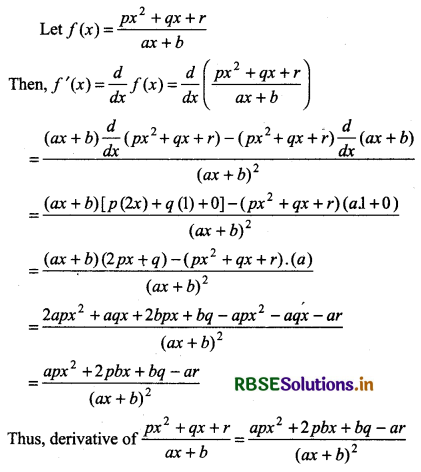

Question 10.
\(\frac{a}{x^4}-\frac{b}{x^2}\) + cos x
Answer:
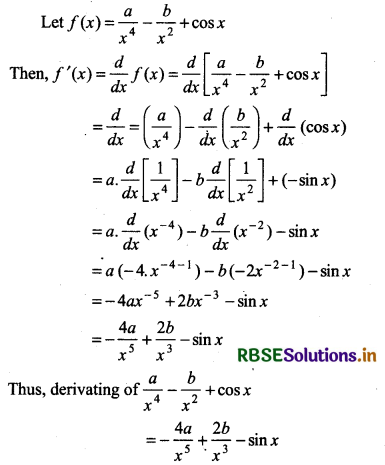
Question 11.
4√x - 2
Answer:
Let f(x) = 4√x - 2

Question 12.
(ax + b)n
Answer:
Let y = ax + b
Then (ax + b)n = yn
Thus, derivative of yn w. r. t. x = \(\frac{d}{d x}\) (yn)

= nyn - 1 (a.1 + 0)
= nayn - 1
= na(ax + b)n - 1
Thus, derivative of given function (ax + b)n

Question 13.
(ax + b)n
Answer:
Let y = (ax + b)
Then yn = (ax + b)

= (ax + b)n. mc (cx + d)m - 1 + (cx + d)m . an(ax + b)n - 1
= (ax + b)n - 1 (cx + d)m - 1 [(ax + b) mc + (cx + d) na]
Thus, derivative of (ax + b)n (cx + d)m
= (ax + b)n - 1 (cx - d)m - 1
[(ax + b) mc + (cx + d) na]
Question 14.
sin (x + a)
Answer:
Let x + a = y and f(x) = sin y
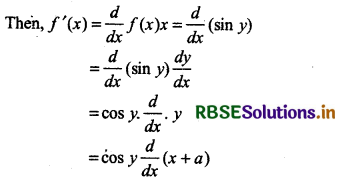
= cos y (1 + 0)
= cos y
= cos (x + a)
Thus, derivative of sin (x + a) = cos (x + a)
Question 15.
cosec x cot x
Answer:
Let f(x) = cosec x cot x
Then, f'(x) = \(\frac{d}{d x}\) f(x) = \(\frac{d}{d x}\) (cosec x cot x)
= cosec x \(\frac{d}{d x}\) (cot x) + cot x \(\frac{d}{d x}\) (cosec x)
= cosec x(- cosec2x) + cot x(- cosec x cot x)
= - cosec3 x - cosec x.cot2 x
Thus, derivative of given functions cosec x .cot x
= - cosec3 x - cosec x.cot2 x

Question 16.
\(\frac{\cos x}{1+\sin x}\)
Answer:

Question 17.
\(\frac{\sin x+\cos x}{\sin x-\cos x}\)
Answer:

Question 18.
\(\frac{\sec x-1}{\sec x+1}\)
Answer:

Question 19.
sinn x
Answer:
Let y = sin x
Then, sinn x = yn
Then, derivative of sinn x
\(\frac{d}{d x}\) sinn x = \(\frac{d}{d x}\) yn
= \(\frac{d}{d y}\) yn.\(\frac{d y}{d x}\)
= nyn - 1 \(\frac{d y}{d x}\)(sin x)
= n sinn - 1 x . cos x
Thus, derivative of given function sinn x
= n sinn - 1 x cos x

Question 20.
\(\frac{a+b \sin x}{c+d \cos x}\)
Answer:

Question 21.
\(\frac{\sin (x+a)}{\cos x}\)
Answer:
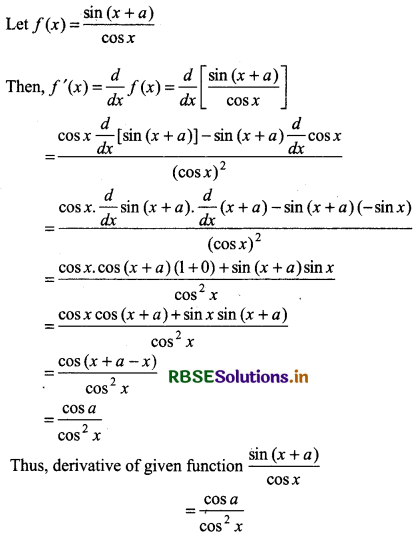

Question 22.
x4 (5 sin x - 3 cos x)
Answer:
Let f(x) = x4 (5 sin x - 3 cos x)
Then f'(x) = \(\frac{d}{d x}\) f(x)
= \(\frac{d}{d x}\) [x4 (5 sin x - 3 cos x)]
= x4 \(\frac{d}{d x}\) (5 sin x - 3 cos x) + (5 sin x - 3 cos x) \(\frac{d}{d x}\) (x4)
= x4 [5 cos x - 3 (- sin x)] + (5 sin x - 3 cos x) 4x3
= x4 (5 cos x + 3 sin x) + 4x3 (5 sin x - 3 cos x)
= 5x4 cos x + 3x4 sin x + 20 x3 sin x - 12x3 cos x
Thus, derivative of given function x4 (5 sin x - 3 cos x)
= 5x4 cos x + 3x4 sin x + 20x3 sin x - 12x3 cos x
Question 23.
(x2 + 1) cos x
Answer:
Let f(x) = (x2 + 1)cos x
Then, f'(x) = \(\frac{d}{d x}\) f(x) = \(\frac{d}{d x}\) [(x2 + 1)cos x]
= (x2 + 1) \(\frac{d}{d x}\) (cos x) + cos x. \(\frac{d}{d x}\) (x2 + 1)
= (x2 + 1) (- sin x) + cos x(2x + 0)
= - x2 sin x - sin x + 2x cos
Derivative of given function (x2 + 1)cos x
= - x2 sin x + 2x cos x
Question 24.
(ax2 + sin x) (p + q cos x)
Answer:
Let f(x) = (ax2 + sin x) (p + q cos x)
Then, f’(x) = \(\frac{d}{d x}\) f(x)
= \(\frac{d}{d x}\) [(ax2 sin x) (p + q cos x)]
= (ax2 + sin x) \(\frac{d}{d x}\) (p + q cos x) + (p + q cos x) \(\frac{d}{d x}\) (ax2 + sin x)
= (ax2 + sin x) [0 + q(- sin x)] + (p + q cos x) [a.(2x) + cos x]
= (ax\(\frac{d}{d x}\) + sin x) (- q sin x) + (p + q cos x)(2ax + cos x)
= - q sin x (ax\(\frac{d}{d x}\) + sin x) + (p + q cos x) (2ax + cos x)
Thus, derivative of given function (ax\(\frac{d}{d x}\) + sin x) (p + q cos x)
= - q sin x(ax2 + sin x) + (p + q cos x) (2ax + cos x)
Question 25.
(x + cos x) (x - tan x)
Answer:
Let f(x) = (x + cos x) (x - tan x)
Then, f’(x) = \(\frac{d}{d x}\)(x)
= \(\frac{d}{d x}\) {(x + cos x) (x - tan x)}
= (x + cos x) \(\frac{d}{d x}\) (x - tan x) + (x - tan x) \(\frac{d}{d x}\) (x + cos x)
= (x + cos x) (1- sec2 x) + (x - tan x) (1 - sin x)
= (x + cos x) (- tan2 x) + (x - tan x) (1 - sin x)
= - tan\(\frac{d}{d x}\) x(x + cos x) + (x - tan x) (1 - sin x)
[∵ sec2 = 1 + tan2 x
∴ 1 - sec2 x = 1 - 1 + tan2 x = tan2 x]
Thus, derivative of given function (x + cos x) (x + tan x)
= - tan2 x (x + cos x) + (x - tan x) (1 - sin x)

Question 26.
\(\frac{4 x+5 \sin x}{3 x+7 \cos x}\)
Answer:

Question 27.
\(\frac{x^2 \cos \left(\frac{\pi}{4}\right)}{\sin x}\)
Answer:


Question 28.
\(\frac{x}{1+\tan x}\)
Answer:

Question 29.
(x + sec x) (x - tan x)
Answer:
Let f(x) = (x + sec x) (x - tan x)
Then, f’(x) = \(\frac{d}{d x}\) f(x)
= \(\frac{d}{d x}\) [(x + sec x) (x - tan x)]
= (x + sec x). \(\frac{d}{d x}\) (x - tan x) + (x - tan x) \(\frac{d}{d x}\) (x + sec x)]
= (x + sec x) [1 - sec2 x] + (x - tan x) [1 + sec x tan x]
= (x + sec x) (1 - sec2 x)
= + (x - tan x) (1 + sec x tan x)
Thus, derivative of given function (x + sec x) (x - tan x)
= (x + sec x) (1 - sec2 x) + (x - tan x) (1 + sec x tan x)

Question 30.
\(\frac{x}{\sin ^n x}\)
Answer:
First, we will find derivative of sinn x
Let, y = sin x
Then, yn = sinn x
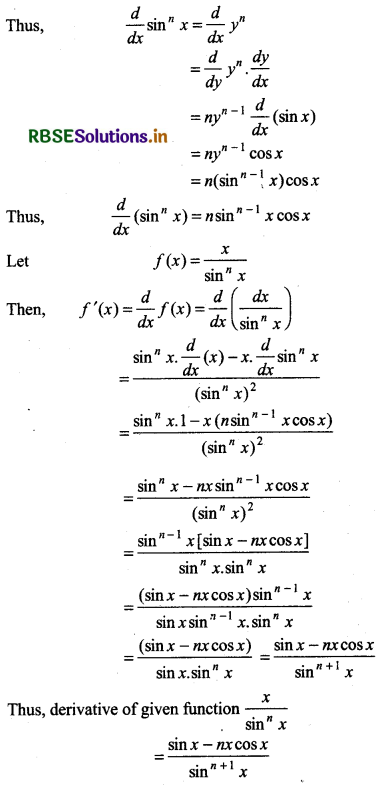
x̄ = \(\frac{6+7+10+12+13+4+8+12}{8}\) = \(\frac{72}{8}\) = 9
Thus, Mean = 9
